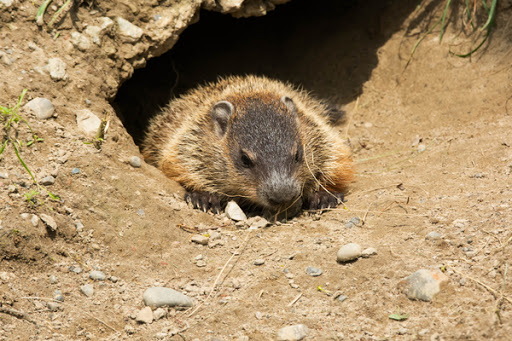Groundhogs live underground in expansive tunnels known as burrows. These burrows can be quite elaborate and often cover a lot of territory. Groundhogs often expand their burrows onto people’s property to access food and other resources. If you see a groundhog near your home, it’s probably living under your yard!
Groundhogs can be a major nuisance. They’ll dig up your lawn, eat your garden, and ruin your turf! If you think you have a groundhog on your property, you should take steps to get rid of it right away. To do that, you’ll have to understand what your groundhog wants in the first place. By understanding what groundhogs are and what they want, you’ll have a much better chance of keeping them away. Here’s what you should know about the groundhogs near you, including how to get them to go away.
What is a groundhog?
Groundhogs (Marmota monax), also known as “woodchucks,” are large rodents in the Sciuridae family of squirrels. The mammals are actually considered a type of large ground squirrel called a marmot. Adult groundhogs are 16 to 22” long and weigh 5 to 13 pounds, which makes them the largest ground squirrels in North America. Groundhogs’ most distinguishing characteristics are their uniform, matted brown fur, large buck teeth, and long, curved front digging claws.
Groundhogs are infamous for their impressive digging ability. They use their digging claws to excavate large, relatively complex underground burrows to live in. During the winter, the marmots dig their burrows deep beneath the frost line and hibernate to survive. In spring, groundhogs emerge from their burrows to seek mates in nearby burrows. They are also forage for food more actively during early to mid spring. During summer, groundhogs will continue foraging, but they’ll spend more time underground. By fall, they’ll ramp up their eating to create fat stores for winter.

Where do groundhogs come from?
Groundhogs are native to north and eastern North America. They’re common in states east of Iowa and Missouri and north of Tennessee. They prefer open fields, prairies, and the edges of woodlands. Obviously, the mammals need to live in places where they can burrow. Consequently, they prefer to live in areas where they can dig quickly, easily, and without running into predators or competition. Groundhogs are naturally solitary animals, and their home territories will only overlap during mating seasons.
Groundhogs never venture very far from their burrows, even during spring time. They tend to expand their burrows from underground to reach new food sources and then create secondary entrances nearby. They’ll use these secondary entrances to forage from their new, nearby food source. If there’s a groundhog on your property, then it’s likely they’ve created one of these secondary entrances around you. The groundhog will come out to feed and sunbathe and return to its burrow frequently.
What do groundhogs want?
Groundhogs make their homes anywhere they can get food, shelter, and space to dig. The marmots are general herbivores, and eat a wide variety of common vegetation. Around homes, they’ll ornamental plants, shrubs, ferns, flowers, grasses, and tree bark. They gnaw on wood constantly to keep their teeth sharp, so they’re particularly attracted to old wood or stumps. You may notice they appear particularly frequently in the spring and fall, when they’re attempting to fatten up for winter.
Groundhogs also tend to move into areas where they can move around and hide easily. Open areas are easy to dig around in, and covered, sheltered areas are easy to hide around. Many will attempt to hide or disguise the entrance to their burrow, often by digging it around natural cover. Sometimes, they may even dig this entrance surprisingly close to your home. If a groundhog comes near you, you have something they want--probably food, cover, shelter, or maybe even a mate!

What can I do about groundhogs?
Preventing groundhogs is all about keeping them from getting what they want on your property. Start by depriving them of shelter. Some often re-use old burrows other animals started. Fill in holes around your home with gravel to prevent groundhogs from re-using them. Next, look for places where they could hide, like the underside of sheds or porches. Cut off these shelters using gravel or wire mesh fencing. Make sure to bury the wire mesh a couple of inches underground!
Next, look for places where rodents could gnaw on their wood. Groundhogs will gnaw on tree stumps, bark, damaged wooden fences and siding, and other vulnerable, soft wood. Remove stumps and other wood debris and repair or otherwise cover damaged structures. Finally, try to deprive them of food. Fence off your garden with underground wire mesh fencing. Keep your grass mowed short and weed frequently. Collect and dispose of fallen fruit or seeds. Trim ornamental grasses or shrubs regularly.
Groundhogs can be difficult to keep away from your property, particularly after they’re established. Even if you plug one a few of their burrow entrances, after all, they’re very good at digging more. Luckily, no matter how tenacious your groundhog, you have options.
If you’re feeling frustrated with groundhogs digging up your yard, give Varment Guard a call. Our experts can safely, humanely, and permanently remove groundhogs from around your home.






